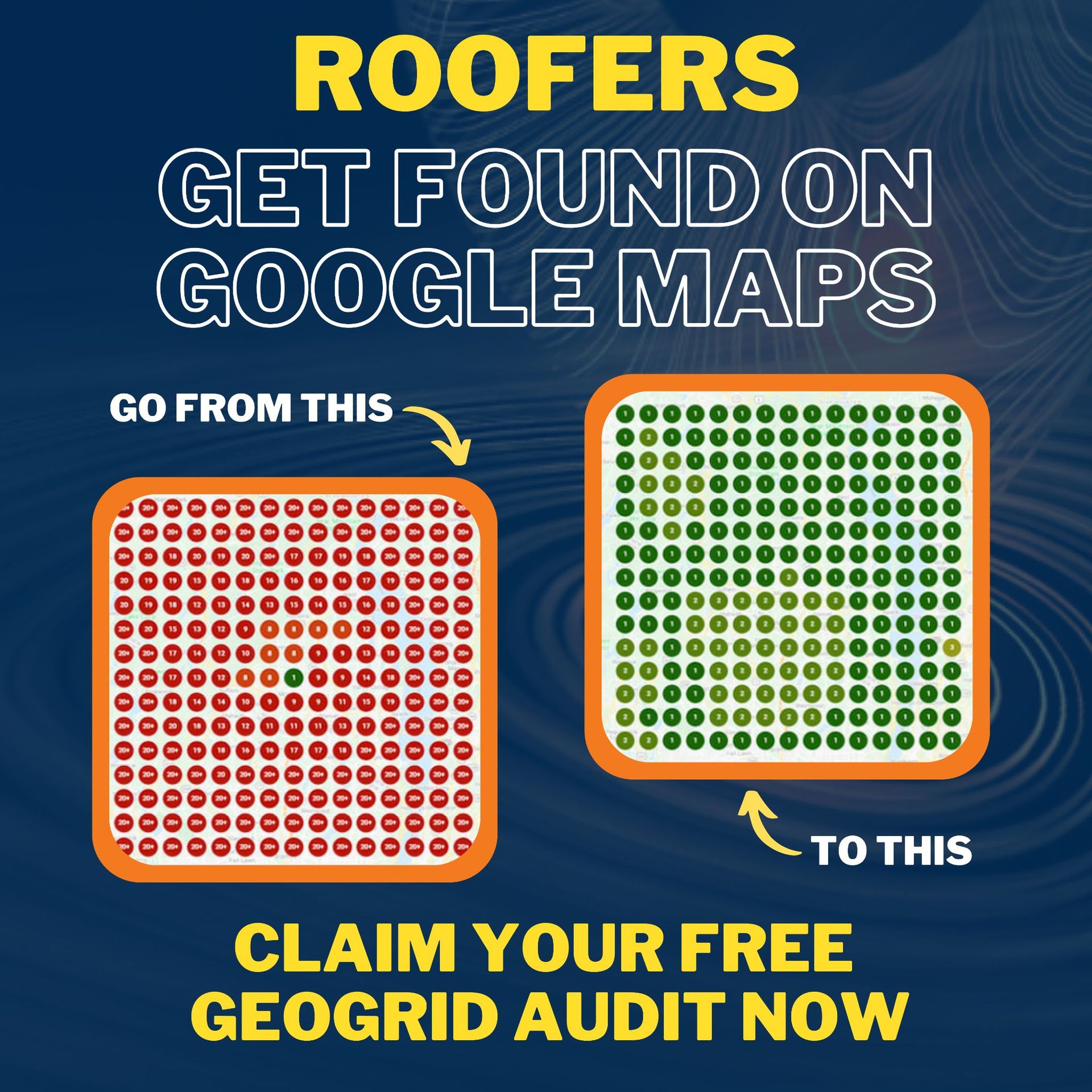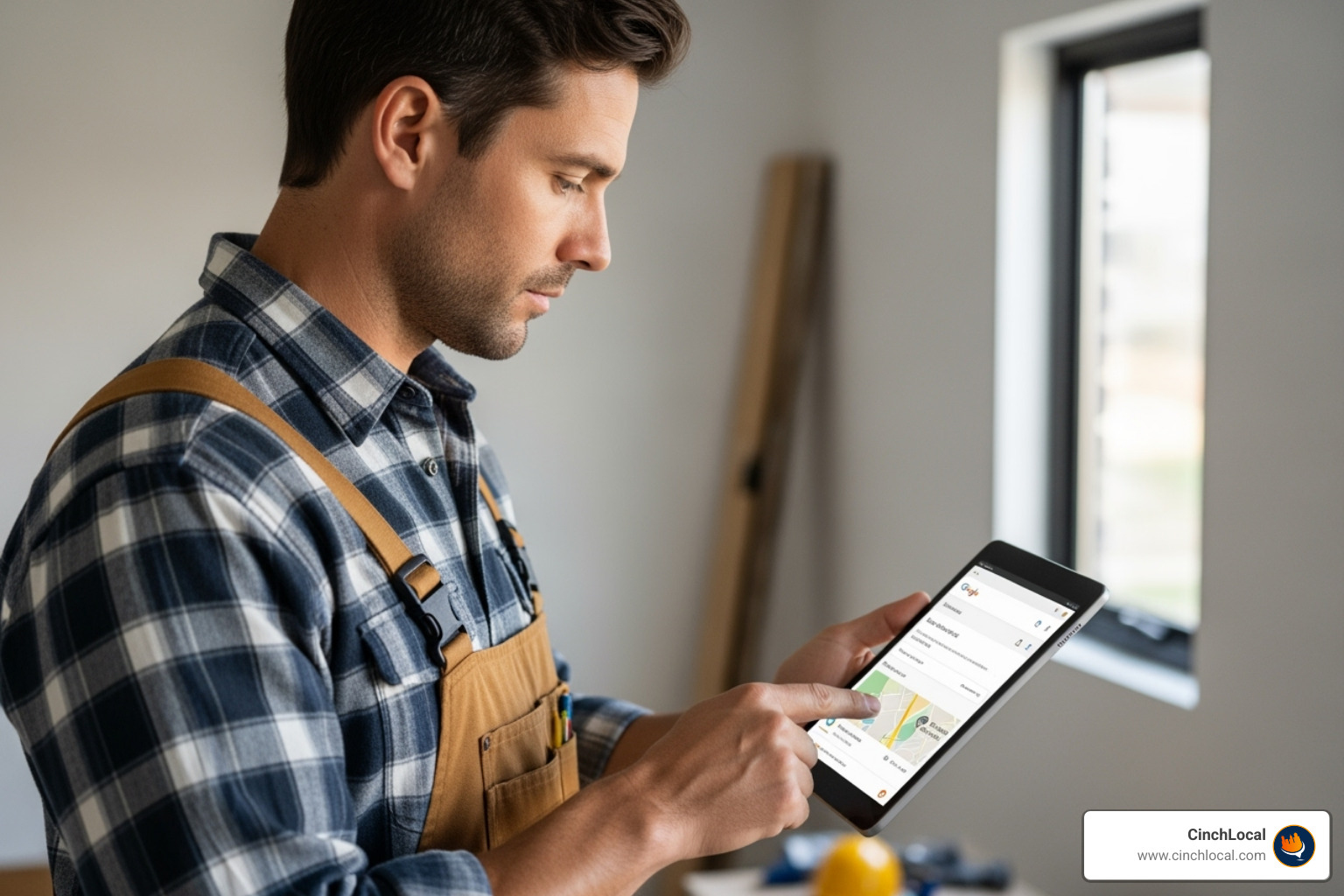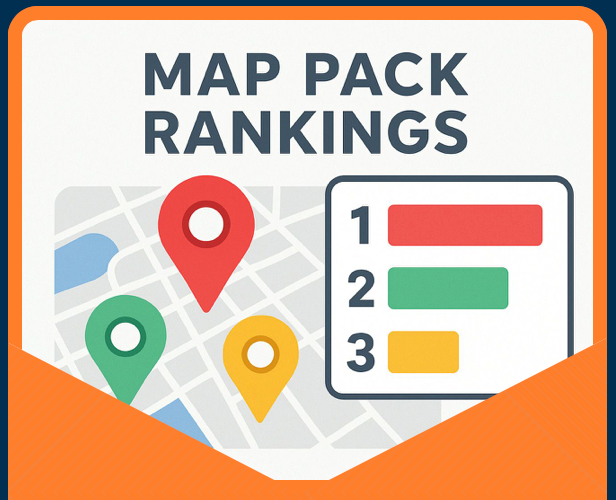
Cary Byrd // Founder of CinchLocal
Why Roof Lead Generation Is the Lifeline of Your Roofing Business

Roof lead generation is the process of attracting and capturing potential customers who need roofing services, converting their interest into sales opportunities through various marketing channels and strategies.
Quick Answer for Roof Lead Generation: • Exclusive leads cost $85-$150+ but convert better than shared leads ($50-$75) • Follow up within 30 minutes to improve conversion rates by up to 391% • Top channels: Local SEO, Google Ads, Facebook Lead Ads, referral programs • Best ROI: Organic search (28.5% CTR) vs PPC (1.91% CTR) • Success factors: Quality over quantity, fast response times, proper lead nurturing
The roofing industry is brutally competitive. Every day, homeowners search for "roofers near me" over 90,000 times per month on Google alone. Yet most roofing contractors struggle to capture their fair share of this massive demand.
Here's the harsh reality: 92% of people read online reviews before contacting a company , and buyers complete 66-90% of their journey before ever picking up the phone. This means traditional door-knocking and word-of-mouth referrals, while still valuable, are no longer enough to sustain consistent growth.
Many roofing companies have reported significant financial benefits from exclusive leads, with some attributing up to half a million dollars in annual business to quality lead generation systems. The difference between thriving and surviving often comes down to having a predictable pipeline of pre-qualified prospects.
The challenge? Not all leads are created equal. Shared leads have very low conversion rates, while exclusive leads command premium prices but deliver measurable ROI. Understanding which lead generation services actually work—and which ones will drain your marketing budget—can make or break your business.
I'm Cary Byrd , CEO and founder of CinchLocal, where I've spent over a decade helping roofing contractors master roof lead generation through proven digital marketing strategies. My experience building successful online marketing systems has shown me exactly what works—and what doesn't—when it comes to generating consistent, high-quality roofing leads.

Understanding Roofing Leads & Pricing
Let's cut through the marketing fluff and talk about what really matters for your roofing business. A roofing lead is simply a potential customer who has raised their hand and said, "I need help with my roof." They've shared their contact information, which means they're genuinely interested in what you offer—not just someone you cold-called during dinner.
But here's where it gets tricky. Not all roof lead generation creates equal opportunities. The difference between a great lead and a waste of money often comes down to one crucial factor: whether you're the only contractor pursuing that prospect.
Think of it this way. Imagine you're at a networking event, and someone mentions they need a new roof. In an exclusive lead scenario , you're having a one-on-one conversation with that person. You can take your time, build trust, and really understand their needs. In a shared lead scenario , you're shouting over five other contractors all trying to pitch the same person at once.
The numbers tell the story clearly. Quality exclusive roofing leads typically cost between $85 and $150 , depending on your market and the complexity of the job. Shared leads might seem like a bargain at $50 to $75 each , but they come with a catch—you're immediately in a price war with multiple competitors.
Here's the kicker that most contractors don't realize: responding within 30 minutes can boost your conversion rates by up to 391%. This isn't just good customer service—it's often the difference between landing a $15,000 project and watching it go to someone else.
| Lead Type | Cost Range | Competition Level | Conversion Rate | Best For |
|---|---|---|---|---|
| Exclusive | $85-$150+ | None (you're the only contractor) | High | Contractors wanting quality over quantity |
| Shared | $50-$75 | 3-10 other contractors | Low | High-volume operations with fast response systems |
Exclusive vs Shared Explained
When you buy an exclusive lead, you're purchasing peace of mind. You know that anxious homeowner isn't fielding calls from a dozen other roofers while you're preparing your estimate. This gives you the breathing room to do what you do best—build relationships and provide real value.
Exclusive leads offer better quality control because the lead provider has skin in the game. If they sell you a bad lead, they can't just shrug and say, "Well, we sold it to ten other people too." They have to make it right with you specifically.
The long-term benefits are even more compelling. Some roofing companies have built half-million-dollar annual revenue streams from exclusive lead sources. When you're not constantly competing on price from the first phone call, you can focus on showcasing your expertise and building trust.
Shared leads create a different dynamic entirely. The homeowner's phone starts ringing within minutes, and suddenly their roofing project feels more like buying a used car than hiring a trusted professional. Everyone's rushing to be first, which often means cutting corners on the consultation process.
The real problem with shared leads? They train customers to shop on price alone. When five contractors are calling within an hour, the natural response is to get five quotes and pick the cheapest one.
How Much Should You Pay?
Lead pricing isn't random—it's driven by real market forces that you can understand and use to your advantage. Location plays the biggest role in determining what you'll pay. A lead in Miami or Los Angeles will cost significantly more than one in a smaller market, simply because there's more competition and higher project values.
The type of work matters too. A homeowner looking for a complete roof replacement represents a much larger opportunity than someone needing a few shingles replaced after a storm. Commercial leads command premium prices because they often involve projects worth tens of thousands of dollars.
Competition level in your area directly impacts what lead providers can charge. In markets saturated with contractors, providers know they can charge more because demand is high. But here's the thing— higher prices often indicate higher-quality markets where customers are willing to invest in proper roofing work.
Storm-chasing opportunities represent a special category. These leads typically cost $75 to $200 because they're time-sensitive and often involve insurance work. The urgency factor means higher conversion rates, but you need systems in place to respond quickly.
The source of the lead also affects pricing. A homeowner who calls directly from a Google search represents higher intent than someone who filled out a form on a generic home improvement site. Real-time phone calls typically cost more than email inquiries , but they also convert at much higher rates.
For most roofing contractors, the sweet spot is exclusive leads in the $100 to $125 range. This price point usually indicates verified contact information, genuine interest, and enough profit margin for the lead provider to maintain quality standards.
The cheapest lead isn't always the best deal. A $50 shared lead that never converts costs more than a $150 exclusive lead that turns into a $20,000 project. Focus on cost per acquisition, not cost per lead.
Proven Digital Strategies for Roof Lead Generation
The digital landscape offers the most scalable and measurable roof lead generation opportunities. Unlike traditional methods, digital strategies provide detailed analytics, precise targeting, and the ability to optimize campaigns in real-time. Let's explore the channels that consistently deliver results for roofing contractors.
The research clearly shows that top organic results on Google receive a 28.5% click-through rate (CTR) compared to only 1.91% for PPC ads . This highlights why a balanced approach combining both organic and paid strategies typically yields the best results. As one industry expert noted, "The most affordable leads for roofers always come through organic clicks, not paid services."
88% of people check their email every day , making email marketing a valuable channel for nurturing and generating roofing leads. However, the key is not just generating leads—it's creating a systematic approach that captures, nurtures, and converts prospects at every stage of the buyer journey.
More info about mastering lead generation
Local SEO Domination for roof lead generation
Local SEO represents the foundation of sustainable roof lead generation . When homeowners search for "roofers near me" or "roof repair [city]," you want your business appearing in the coveted Map 3-Pack and top organic results. The research emphasizes that maintaining consistent NAP (Name, Address, Phone) across all listings is crucial for local search success.
Creating service area pages for each location you serve helps capture long-tail local searches. A mobile-friendly website isn't optional—it's essential, as most roofing searches happen on smartphones, often during or immediately after finding roof damage. On-page keyword optimization should focus on location-specific terms combined with roofing services.
Your Google Business Profile listing serves as your digital storefront. Complete profiles with photos, reviews, and regular posts significantly outperform bare-bones listings. The research shows that 93% of consumers are influenced by online reviews , making review generation and management a critical component of local SEO success.
PPC & LSA: Fast-Track roof lead generation
Pay-per-click advertising and Local Service Ads offer the fastest path to roof lead generation , often delivering leads within the first month of launch. The key is intent targeting—bidding on keywords that indicate immediate need, such as "emergency roof repair" or "roof leak fix."
Call extensions are particularly effective for roofing services, as many homeowners prefer speaking directly with contractors about urgent issues. Budget control allows you to scale spending based on performance, making PPC a scalable growth channel when managed properly.
Google Local Service Ads often provide a lower cost alternative to traditional Google Ads for roofers, with the added benefit of the Google Guarantee badge that builds immediate trust with prospects. The research indicates that contractors following up on leads within 30 minutes are eligible for discounts with many lead providers.
Social Media & Video
Meta Lead Ads on Facebook and Instagram have become increasingly effective for roofing contractors, particularly when combined with video content showcasing before-and-after changes. 92% of video marketers report good ROI from video , and 70% of viewers purchased after seeing a YouTube ad .
YouTube ads targeting homeowners researching roofing solutions can capture prospects early in their decision-making process. User-generated content, such as customer testimonials and project documentation, builds authenticity and trust that traditional advertising can't match.
The research reveals that 91% of consumers want more video content from brands , making video a critical component of modern roof lead generation strategies.

The Top 7 Roof Lead Generation Service Models
Understanding the different service models available helps you choose the right approach for your business size, budget, and growth goals. Each model offers distinct advantages and challenges, and the best contractors often use a combination of approaches to diversify their lead sources.

Exclusive Pay-Per-Lead Networks
Exclusive pay-per-lead networks represent the premium tier of roof lead generation services. These platforms generate leads through multi-channel marketing efforts and sell each lead to only one contractor in a given service area. The research shows that RoofClaim has helped roofers sell over 10,000 jobs across eleven states using their $99 exclusive lead model .
Real-time call delivery ensures you're speaking with prospects while their need is most urgent. Quality guarantees typically include credits for invalid contact information or prospects not genuinely interested in roofing services. The trade-off is higher cost per lead, but the conversion rates often justify the investment.
Many exclusive networks offer additional services like lead verification, where every lead's phone number is verified for authenticity before forwarding to contractors. This quality control step significantly improves the likelihood of reaching genuine prospects.
Local SEO & Content Platforms
Local SEO and content platforms focus on building long-term organic visibility rather than purchasing individual leads. These services help contractors dominate local search results through comprehensive SEO strategies, content marketing, and authority building.
The research indicates that organic traffic delivers the lowest cost per lead and highest lifetime customer value for roofers. While results take longer to materialize—typically 6 months for significant SEO improvements—the long-term ROI often exceeds paid lead generation methods.
Content platforms help contractors establish expertise through educational blog posts, how-to videos, and resource libraries that attract prospects throughout their research phase. This approach builds brand recognition and trust before prospects are ready to buy.
Storm & Weather Data Systems
Storm and weather data systems represent one of the most innovative approaches to roof lead generation . These platforms use meteorological data to identify areas recently affected by hail, wind, or severe weather, providing contractors with precise canvassing targets.
The research mentions using storm and hail tracking for targeted canvassing as a creative lead generation strategy. Drive-by repair identification allows contractors to proactively identify properties with visible damage and reach out to homeowners who may not yet realize they need repairs.
Timely outreach following weather events often yields high conversion rates, as homeowners are dealing with immediate, urgent needs rather than future planning scenarios.
Managing & Converting Leads Like a Pro
The moment a lead comes in, the clock starts ticking. Roof lead generation is just the beginning—the real magic happens when you systematically convert those prospects into paying customers. The difference between successful roofing contractors and those who struggle often comes down to having the right processes and technology in place.
The research is crystal clear: roofers who answer calls and emails right away convert a higher percentage of their leads than those who don't . It sounds simple, but you'd be amazed how many contractors let leads go cold while they're busy on job sites or dealing with other customers.
Lead scoring becomes your secret weapon for prioritizing follow-up efforts. Not all leads are created equal—a homeowner with a leaking roof needs immediate attention, while someone planning a replacement for next year can wait a bit longer. By ranking prospects based on urgency, project size, and likelihood to convert, you can focus your energy where it matters most.
The 30-minute rule isn't just a nice suggestion—it's a proven conversion multiplier that can make or break your business. Speed-to-lead directly impacts your bottom line, and contractors who master this simple principle often see dramatic improvements in their close rates.
CRM integration ensures no leads slip through the cracks. There's nothing worse than realizing you forgot to follow up with a qualified prospect because their information got buried in a pile of sticky notes. Automation handles the routine follow-up tasks, freeing you to focus on what you do best—estimating projects and managing jobs.
Review requests should happen automatically at the right moments in your customer journey. Happy customers are usually willing to leave reviews, but only if you make it easy and ask at the optimal time.

Tech Stack Essentials for roof lead generation
Your technology stack doesn't need to be complicated, but it does need to work seamlessly together. A cloud-based CRM system designed for contractors becomes the central hub where all your lead information lives. The research shows that CRM platforms designed for roofers can significantly reduce negative reviews by improving communication and follow-up processes.
Call tracking provides the analytics you need to make smart marketing decisions. When you know which marketing channels are generating actual phone calls versus just website visits, you can allocate your budget more effectively. There's no point spending money on channels that don't drive real business.
Email automation sequences keep you in front of prospects who aren't ready to buy today but might be next month or next season. These nurture campaigns work behind the scenes, sharing helpful content and building trust over time. The key is providing value, not just pitching your services repeatedly.
Mobile CRM access is non-negotiable in today's roofing business. Your field teams need to update lead information and schedule follow-ups while they're out on job sites. This real-time communication ensures nothing falls through the cracks and every prospect feels valued throughout the sales process.
Best Practices to Boost Close Rates
The 30-minute rule for initial response remains the gold standard, but what happens after that first contact is equally important. Multi-touch follow-up sequences should include a mix of phone calls, emails, and text messages spread over several weeks. Different prospects prefer different communication methods, and you want to meet them where they're most comfortable.
Personalized estimates that address specific prospect concerns show you've been listening. Generic proposals feel like spam, while detailed explanations of recommended solutions demonstrate expertise and build confidence. Take time to understand each homeowner's unique situation and tailor your approach accordingly.
The research emphasizes that providing exceptional service and nurturing leads with personalized content increases the likelihood of referrals . Every interaction is an opportunity to exceed expectations and create a customer who becomes a walking advertisement for your business.
Professional proposals that clearly outline scope, timeline, materials, and pricing help prospects make informed decisions. Confusion kills sales, so make everything as clear and straightforward as possible. When homeowners understand exactly what they're getting and when they'll get it, they're much more likely to move forward with confidence.
Measuring ROI & Avoiding Common Pitfalls

Here's the truth about measuring roof lead generation success: most contractors are tracking the wrong numbers. They get excited about lead volume while their bank account tells a different story. The real measure of success isn't how many leads you get—it's how much profit those leads actually generate for your business.
Understanding your true return on investment starts with tracking the right metrics. Cost-per-lead gives you a starting point , but it's just the tip of the iceberg. Your customer acquisition cost needs to include everything: the lead cost, your sales time, follow-up expenses, and even the gas money spent driving to estimates.
The magic number you really need to know is lifetime customer value . A lead that costs $150 might seem expensive until that customer becomes a $25,000 roof replacement plus three referrals over the next two years. This is why smart contractors are willing to pay premium prices for high-quality exclusive leads.
Attribution tracking often reveals surprising insights about your lead sources. You might find that prospects who find you through organic search actually called the phone number from your Google Ad, or that social media followers convert after reading your email newsletter. Without proper tracking, you could accidentally cut funding to your most effective channels.
The research shows that 74% say good reviews make a local business more trustworthy , which means your review generation and management directly impacts lead conversion rates. Yet many contractors ignore this connection when calculating ROI from their roof lead generation efforts.
Scientific research on online reviews
Tracking & Reporting Framework
Building a solid tracking system doesn't require a PhD in analytics. Monthly dashboard reviews should focus on the numbers that actually matter to your bottom line: lead volume by source, conversion rates, cost per customer acquired, and total revenue generated by each marketing channel.
UTM tags on all your digital campaigns act like invisible tracking codes that follow prospects from their first click to their final payment. This simple addition to your website links provides crystal-clear data about which specific ads, emails, or social media posts are driving actual business.
The seasonal nature of roofing means your tracking needs to account for natural fluctuations in demand. Budget allocation should shift based on historical performance patterns —storm season might justify higher spending on emergency repair keywords, while winter months could focus more on planning for spring projects.
Regular performance reviews help you spot trends before they become problems. Maybe your cost-per-lead is creeping up in certain zip codes, or perhaps your conversion rate drops when leads take longer than 24 hours to respond. These insights only become actionable when you're consistently monitoring the right metrics.
Red Flags to Watch
After working with hundreds of roofing contractors, I've seen the same costly mistakes repeated over and over. Hidden fees are perhaps the most common trap—services advertised at $75 per lead that suddenly include "platform fees," "technology charges," or "premium placement costs" that double your actual investment.
Long-term contracts should make you especially cautious. The best lead generation services are confident enough in their results to work month-to-month. If a company insists on locking you into a year-long agreement, they're probably more concerned about their cash flow than your success.
Unverified leads represent another major red flag. Quality providers verify phone numbers, confirm genuine interest, and often pre-qualify prospects before sending them your way. If you're getting leads with disconnected numbers or people who have never heard of your company, you're dealing with a low-quality service.
The research warns that "low-cost lead generation firms often provide poor-quality, shared leads." When leads seem too cheap to be true, they usually are. Those $25 "exclusive" leads are often shared with multiple contractors, creating bidding wars that benefit no one except the lead seller.
Watch out for services that can't provide clear performance metrics or refuse to share client references. Legitimate lead generation companies are proud of their results and happy to connect you with satisfied customers. Vague promises about "guaranteed results" without specific metrics should trigger immediate skepticism.
Frequently Asked Questions about roof lead generation
Let's tackle the most common questions I hear from roofing contractors who are ready to take their roof lead generation seriously. These aren't just theoretical concerns—they're real challenges that can make or break your marketing budget.
What are roofing leads and why are they vital?
Think of roofing leads as the difference between knocking on random doors and having homeowners call you directly. Roofing leads are potential customers who have already raised their hand and said "I need help with my roof." They've provided their contact information because they're actively seeking solutions.
Here's why they're absolutely vital: these prospects are pre-qualified and ready to buy. Instead of spending your day chasing people who might need roofing someday, you're talking to homeowners who need roofing today. The research shows that qualified and exclusive leads are the engine that drives new business for roofing contractors.
The beauty of quality leads is timing. When someone fills out a form or calls about roof damage, they're not browsing—they're buying. That urgency translates directly into higher conversion rates and faster sales cycles.
How do exclusive leads differ from shared?
This is where many contractors get burned. Exclusive leads go only to your company , which means you're having a conversation, not entering a bidding war. When you get an exclusive lead, you can take time to build rapport, ask questions, and provide a thoughtful estimate without worrying about three other contractors calling the same homeowner.
Shared leads create an entirely different scenario. The moment that lead hits your inbox, it's also hitting the inboxes of multiple competitors. You're immediately in a race to call first, quote lowest, or somehow stand out from the crowd. The homeowner often feels overwhelmed by the flood of calls and emails.
The numbers tell the story: exclusive leads cost $85-$150+ while shared leads cost $50-$75 . That price difference might seem steep until you factor in conversion rates. Exclusive leads convert at significantly higher rates because you're not competing for attention. The higher investment often pays for itself through better close rates and higher project values.
Which digital channel delivers the best ROI?
This question reveals a common misconception about roof lead generation . There's no single "best" channel—there's the best approach for your specific situation and timeline.
Organic search consistently delivers the best long-term ROI , with top organic results receiving a 28.5% click-through rate versus only 1.91% for PPC ads . When homeowners find you naturally through Google search, they're more likely to trust your expertise and less likely to shop around aggressively.
But here's the catch: organic results take time. If you need leads next month, SEO won't save you. That's where PPC and Local Service Ads provide faster results , often generating leads within the first month of launch.
The most successful contractors I work with use what I call the "two-engine approach." They invest in SEO for sustainable, long-term growth while running targeted ads for immediate lead flow. This strategy ensures consistent leads today while building the foundation for even better results tomorrow.
Your local market also influences which channels work best. In highly competitive areas, paid advertising might be necessary to break through the noise. In smaller markets, a well-optimized Google Business Profile and solid SEO foundation might be enough to dominate local search results.
Conclusion
Roof lead generation success boils down to three fundamental pillars: investing in quality leads, responding lightning-fast, and building an unshakeable online reputation. Throughout our research, we've seen time and again how contractors who master these basics consistently outperform those still relying on door-knocking and hoping for the best.
The roofing industry has fundamentally changed. Homeowners now complete most of their research online before ever picking up the phone. This shift isn't a threat—it's an incredible opportunity for contractors willing to adapt and accept proven digital strategies.
At CinchLocal, we've built our Roofer Footprint Expansion System specifically to address these modern realities. We guarantee increased Google Maps visibility and pre-sold leads within 30 days because we understand exactly what works in today's digital landscape. We've watched struggling roofing businesses transform into market leaders simply by implementing the right combination of local SEO, reputation management, and systematic lead nurturing.
Here's what really matters for your success: prioritize exclusive leads over the tempting low prices of shared leads—the conversion rates speak for themselves. Master the 30-minute response rule because speed literally translates to money in this business. Balance your approach between organic SEO for sustainable long-term growth and paid advertising for immediate cash flow.
Don't let technology overwhelm you— use simple automation to handle follow-up sequences so no potential customer slips through the cracks. Most importantly, track your numbers religiously and avoid any service that can't show you clear ROI or tries to lock you into long-term contracts with hidden fees.
Your next move should be taking an honest look at your current lead generation efforts. Are you getting enough exclusive leads? Is your Google Maps presence where it needs to be? Do you have a systematic way to follow up with prospects? Small improvements in these areas can create dramatic business growth.
The opportunity is massive—over 90,000 people search for roofers every month. The question is whether you'll be ready to capture your fair share of that demand with a modern, systematic approach to roof lead generation .
Want Us to Uncover Hidden 'Footprint Gaps' And Critical Blind Spots That’s Quietly Draining Calls, Jobs, and Profits?
Simply Fill Out The Form Below:








